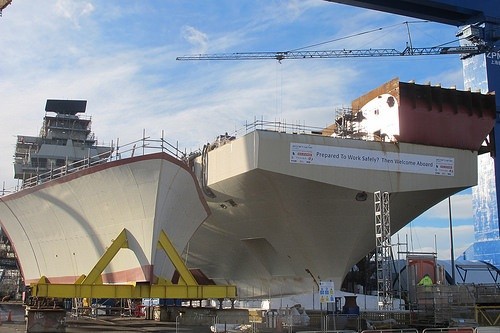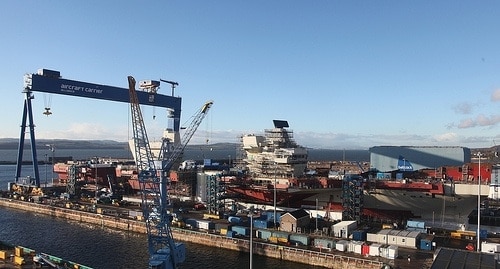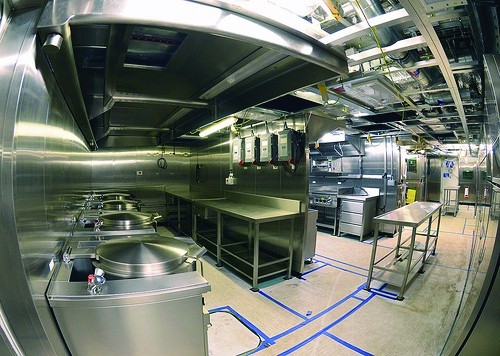Looking back on 2013, the Aircraft Carrier Alliance (ACA) achieved a great deal in the assembly of HMS Queen Elizabeth - the first of the two new aircraft carriers for the Royal Navy.
At the end of 2012, the two major sections of the hull had been skidded into alignment within the build dock at Rosyth. Since that time the remaining upper and sponson blocks have been assembled onto the hull, the two islands have been shipped and welded into position, the take off ramp has been fitted, and the Long Range Radar assembled on the top of the mast of the forward island.
At the end of January 2014, the hull is now structurally complete and the scale of this iconic ship is clear for all to see. Since the manufacturing phase contract was let to the ACA in the middle of 2008 and looking back over the construction and assembly process, it is pleasing to say that all the major evolutions have happened at or before the programmed date. However, as everyone tells us, assembling the hull is the easy bit, commissioning and setting it all to work and proving the design is still largely ahead of us.

2014 is going to be an interesting and historic year for the project, working towards the naming ceremony for HMS Queen Elizabeth in the summer, followed by flooding up the dock, floating the ship out and mooring her within the non-tidal basin at Rosyth for the next phase of the work. This will be the point where the ship goes from being a building site to becoming a real floating ship.
Once berthed in the non-tidal basin, the ship’s High Voltage system will go live, initially from a shore supply, with preparations taking place to start the ship’s generators and then onwards to propulsion trials. Once HMS Queen Elizabeth has vacated the dry dock there will be just a few weeks to rearrange the dock blocks before the first sections of the HMS Prince of Wales arrive in Rosyth, commencing the assembly sequence for the second ship.

Having a key event such as the naming ceremony and flood up planned for the year really focusses the mind, and a detailed plan of work requiring completion in advance of these evolutions is being worked to.
The fuel, aviation fuel, fresh water and ballast water tanks together with their associated cofferdams and sea chests are all being completed, painted and signed off. The installation of the shafts and the brake blades that will allow the shafts to be turned at up to full speed and up to 50% full power is starting. The underwater hull is being shot blasted and painted with anti-fouling paint which is intended to last until the ship’s first planned docking over 5 years away. Painting of the topsides is underway within the constraints of the great Scottish weather!

On the upper deck, the catwalks around the edge of the flight deck are being prepared and will shortly be painted with a heat resistant paint scheme. This will survive the thermal effects of the exhaust of an F35 jet while hovering on the approach to a vertical landing. This work also entails application of the thermal metal spray coating to the edges of the flight deck. This coating system will later be applied across the whole flight deck.
The aircraft lift platforms are being prepared for installation. As might be expected there are a fair number of challenges in the installation and alignment of these massive lifts, but a clear plan now exists to install both lift platforms at the beginning of April.
Meanwhile recognising that access to the ship and craneage is much easier while the ship is in the dry dock, served by the Goliath crane, than when afloat in the non-tidal basin, the chance is being taken to install anything that might be difficult to do later. This includes the platform at the stern for the SPN 41 Precision Approach Radar, the seating’s for the Glide Path Cameras and some CCTV cameras. It looks like 2014 is going to be another busy but very interesting year.





JLR teams with Allye Energy on portable battery storage
This illustrates the lengths required to operate electric vehicles in some circumstances. It is just as well few electric Range Rovers will go off...